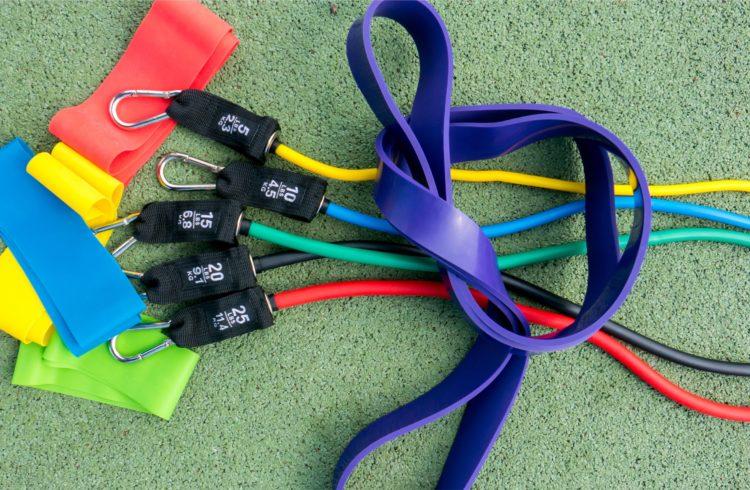Resistance Bands for the Win
Apr 29, 2022 • 5min read
You’ve heard of them. You’ve probably seen them hanging on a hook at the gym. Or maybe you even own a set that is currently collecting dust in an unknown location within your home. Those colorful, stretchy bands—sometimes with handles, sometimes not—can be your new workout buddy, but there are some basics you need to know first.
Resistance bands can certainly be intimidating if you’re just getting started working out. Knowing which color band to use and which exercises to do, can be confusing and may even discourage you from picking them up. After reading this article, though, you’ll be equipped with the basic knowledge to get started using resistance bands and feel confident that adding them to your workout will help you achieve your fitness goals.
What are Resistance Bands?
Several different types of stretchy workout bands can be considered resistance bands. Overall, they’re a great way to incorporate strength training into your workout routine, easily, affordably, and without large, bulky equipment.
There are shorter, looped versions of resistance bands commonly known as booty bands or hip bands, which range from 8-inches to 10-inches long and are typically sold in sets of two to four, ranging from light resistance to heavy. These shorter looped bands can be placed around your legs while you’re lunging, squatting, kicking, or bridging your way to a more toned backside and lower body.
The longer variety of resistance bands with handles are typically called tube bands (named after their tubelike shape) and vary in resistance level from light to heavy. They can also be classified in different weighted amounts like 5-pounds, 10-pounds, and so on. Tube bands are easy to layer together to increase weight resistance and challenge your muscles as you get stronger, thanks to the clip system commonly found between the handle and the band. The handles on these types of resistance bands make them great for upper body workouts.
Looped resistance bands can also be longer in length (most average about 40” long) like tube bands and can help increase strength and flexibility through a variety of workouts for both your upper and lower body, whereas the shorter looped bands (booty bands) are typically used to focus on the lower body and glutes.
Do Resistance Bands Actually Work?
Though free weights and dumbbells have generally been a top choice for weightlifting and resistance training, resistance bands are also a great option for building lean muscle and strength during your workouts.
Resistance bands can challenge your muscles in a different way, sometimes even more thoroughly, than a dumbbell workout. When you’re lifting dumbbells, the resistance changes depending on where the weight is in relation to your body, but with resistance bands, the weight gets increasingly heavier as the bands stretch, and there is constant tension on the muscle. You can very easily adjust your resistance level by changing the length of the band; shorter lengths challenge your muscles more heavily while longer lengths ease some of the tension.
So, do resistance bands actually work? Yes, they really do.
What Type of Resistance Bands are Best?
The type of resistance band you choose should depend on your overall fitness goals and specific areas of the body you’re targeting.
If you’re just getting started with resistance bands, the more versatile tube bands are your best bet. Sets of tube bands generally have multiple band options that can easily be clipped on or off the handles to allow maximum flexibility in your workout routine. The handles also make it easier to grip the bands and lessen the discomfort of holding the bands compared to a set without handles.
As you progress beyond the basics, you can challenge yourself and specific areas of the body with both the shorter and longer looped varieties of resistance bands.
Can Resistance Bands Help You Lose Weight?
To lose weight, you must burn more calories than you’re taking in. Burning calories can be accomplished in a variety of ways, from cardio to strength training, and many more. While cardio burns a lot of calories during a workout, strength training is also essential to aid in weight loss because muscle helps boost your metabolism and burn more body fat.
When you train with resistance bands, you’re challenging your muscles and burning calories. So, while resistance bands can in fact help you lose weight, there are other considerations at play, like the combination of exercise plus diet.
Tips on Getting Started with Resistance Bands
If you’re new to resistance bands, it’s best to start off slow. Incorporate them into your warmup or pre-workout stretching routine first, then switch out your dumbbells or weight machine for resistance bands to see how you like them, and how your body reacts. If your muscles are sore the next day after using resistance bands, even though it’s an exercise you’ve done many times previously, congratulations—you’re finding new ways to work the same muscle groups, which means quicker results toward your fitness goals.
Add Variety With Resistance Bands
They’re versatile, allowing you to work your arms, legs, core, and every muscle group in between. They’re compact and easily transported on work trips or simply trips to the park. They’re affordable and come in many shapes, colors, and resistance levels. They can help you work your muscles differently than you’re used to, helping you add variety in your workout routine and cutting down on potential burnout.
If you haven’t tried them or it’s been a while, now is your opportunity to see what resistance bands can do for you.
Grab some bands and try them out at your local EōS Fitness with a Free 7-Day Gym Pass.

